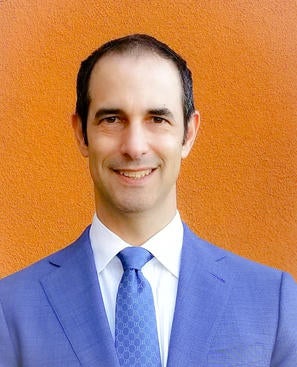
The coronavirus pandemic has laid bare all manner of social issues and disparities, from child care accessibility to the weaknesses of an underfunded public health system.
But to Lloyd Levine ’92, one of the starkest disparities to come into focus is the digital divide — the invisible line that separates technology “haves” from “have-nots.”
Levine is a senior policy fellow in the School of Public Policy at the University of California, Riverside, and one of the state’s leading experts on technology policy. A former member of the California State Legislature, he chaired the Assembly Committee on Utilities and Commerce and now serves as president of the firm Filament Strategies, providing consulting services in the technology and environmental sectors.
It was during Levine’s time on the legislative committee — which was charged with overseeing policy related to broadband internet, telecommunications, and cable TV, among other areas — that he became increasingly aware of and interested in developing solutions to bridge the digital divide.
About 25% of Californians lack meaningful access to the internet at home, Levine said. The bulk of those — about 2 million households — are concentrated in urban and suburban areas, with an additional 500,000 to 600,000 households going without access in rural areas.
“For rural households, the issue is about the high cost of building the infrastructure to deploy internet service to more remote areas,” Levine explained. “For urban and suburban households, it’s about the costs of the service itself and of the devices needed to use it.”
In California, rates of household internet access tend to precipitously drop off around an annual income range of about $20,000 to $30,000 per year, Levine said. What’s more, in surveys of urban and suburban households that lack internet access, respondents consistently list “cost of service” and “cost of device” as the biggest barriers to access.
“These are people who know what the internet is, what it does, and how they could use it,” Levine said. “They just flat-out can’t afford the service or a computing device, so they use a cellphone instead, but research shows people who rely on a cellphone for their internet access suffer harms just as great as those who have no internet access at all.”
Think about trying to build a resume or fill out a job application on a smartphone, Levine explained. Both tasks would be made substantially more difficult than if you were able to use a traditional computing device.
That doesn’t even account for how many government services have moved online in recent years, such as quick, convenient driver’s license and car registration renewals through the Department of Motor Vehicles.
“We’re shifting so many government services to the internet, but we’re not necessarily making the internet more accessible to those who need it,” Levine said. “By doing that, we’re disenfranchising people and dooming them to more economic hardship.”
While the coronavirus pandemic didn’t create the digital divide or make it more severe, it has shoved it to the forefront, creating a domino effect of challenges that will only serve to exacerbate existing disparities, according to Levine.
Perhaps nowhere are those challenges more evident than when it comes to children’s distance learning. As schools began to close their doors in March to curb the spread of COVID-19, districts discovered many of their students lacked access to the internet or computing devices at home.
Many have since tried to remedy the situation by distributing devices such as Chromebooks to K-12 students who need them. Yet Levine said serious issues remain when it comes to service access and bandwidth, especially for families with multiple children who need to log on daily.
Moreover, additional difficulties arise in households with younger children whose parents aren’t technologically literate, or whose parents didn’t grow up in the U.S. education system or don’t speak English as a first language or at all.
Recently, Levine has raised awareness of the issue through his writing and media appearances, exploring topics related to digital inequality, COVID-19, and distance learning in the journal Social Inclusion, on the podcast (in)CITE, and in a working paper published by the School of Public Policy, among other outlets.
“We’ve inverted the paradigm here,” he said. “In many cases, the teacher is no longer the primary educator, and the reality is we need to help parents more than we would’ve otherwise.”
Beyond the pandemic, that help should be part of a more strategic vision to close the digital divide through policy solutions, he added.
So far, the bulk of money allocated to fix the divide has gone toward improving rural access through federal and state programs such as the American Recovery and Reinvestment Act, the California Advanced Services Fund, and the Connect America Fund. Levine admitted more could be done in that area.
“The biggest cost in deploying broadband is not actually the fiber itself; it’s the trenching needed to get to more remote, rural areas,” he said. “In California, there are things we could be doing to improve that system. Any time Caltrans digs up a strategic corridor, for instance, they could be laying conduit.”
But in urban and suburban areas, those solutions won’t fix a glaring problem: For many households, the price of even low-cost internet is still too high.
In an article published in June in the Journal of Information, Communication, and Ethics in Society, Levine assesses some of the strategies utilized thus far to close the digital divide.
In particular, he spotlights several efforts primarily undertaken by community-based organizations to increase Californians’ awareness of programs designed to help them access affordably priced broadband and devices.
In surveying programs that have been run for the past 10 years to close the digital divide, Levine found they have generally been unsuccessful when it comes to increasing access.
“Even when people are presented with information about low-cost internet and device programs, they’re still not signing up,” he said. “These are households that don’t have $10 or $15 a month to spend on broadband plus a computing device, so what it boils down to is that we’ve been telling people about something they can’t afford.”
In Levine’s view, a more effective option would be to treat the internet as any other utility and craft policy that mandates ongoing financial assistance to ensure people have access to it. In fact, he thinks the government has an ethical obligation to do so in light of the economic and educational harms people are becoming progressively more likely to suffer without it.
“I’m not going out on a policy limb here; there’s a whole host of programs out there through which we’ve provided people with financial assistance for other utilities — for natural gas, for electricity, for water, for telephones,” Levine said, noting it’s time to do the same thing for broadband.
“We need to provide a monthly subsidy in some form to offset the cost of service,” he added. “And we need to figure out how to get the devices to use it in people’s hands.”
The full title of Levine’s article in the Journal of Information, Communication, and Ethics in Society is “Broadband adoption in urban and suburban California: information-based outreach programs ineffective at closing the digital divide.”
The full title of Levine's article in the journal Social Inclusion is "Digital Inclusion Across the Americas and Caribbean."
The full title of Levine's working paper published by the School of Public Policy is "COVID-19, the Digital Divide, Distance Learning: Strategies and Policies to Avert an Education Crisis."
Listen to Levine's on California IT in Education's in(CITE) podcast here.
Header image by Kaitlyn Baker via Unsplash




